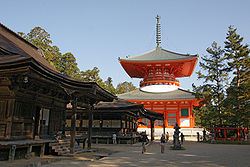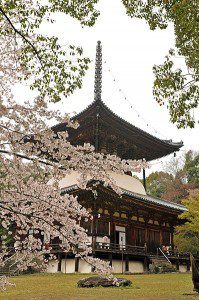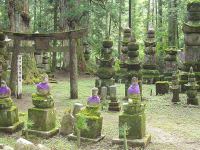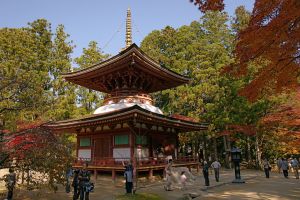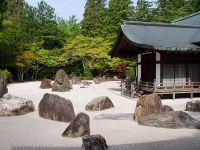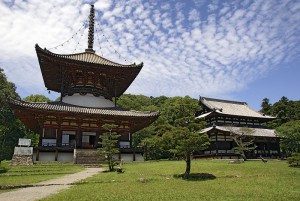Japan Tourism and Stunning Wakayama: Ticking Clock of Buddhism in Koyasan and Negoro-Ji
Noriko Watanabe and Lee Jay Walker
Modern Tokyo Times
If visitors to Japan have time to connect with spirituality, then Koyasan and Negoro-ji are charming places to visit in Wakayama, where living Buddhism is still ticking strongly. Indeed, the prefecture of Wakayama is famous for other holy places to visit, irrespective if Buddhist or Shinto. This notably applies to the Kumano Kodo pilgrimage (Kumano is located in the Kii Peninsula but this holy place also exists outside of Wakayama), Nachi-no-taki Falls, and Nachi-Katsuura. Therefore, while images of Kyoto, Nara, and Nikko, will spring to mind for most international tourists visiting Japan, the truth is that Wakayama is blessed with so much to offer.
Negoro-ji is blessed with a lovely mountainous backdrop that fits in splendidly with the many Buddhist holy temples to visit. Indeed, if culture, history, nature, and spirituality, are your foundations then this intriguing part of Wakayama is most rewarding.
The Katsuragi Mountains and plentiful holy places to visit takes you back in time. Yet, in Buddhism, the meaning of time is very different. Hence, hearing Buddhist chants, witnessing priests connecting with the past, now, and future, and taking in the stunning architecture is a real treat. Similarly, several lovely gardens connected to Buddhism in Negoro-ji and walks will help to free the mind.
In history, Negoro-ji (known by the name of Hofuku-ji in the past) is extremely rich and of high importance for Buddhism in this part of Japan. Of course, the same applies to Koyasan. The emergence of Negoro-ji began in 1087 based on En no Gyoja and Hofuku-Choja, who were inspired by spirituality and the need to firmly entrench the Buddhist faith throughout the region – thereby, connecting with Koyasan.
Modern Tokyo Times in a past article, says, “The Buddhist leader Kakuban (1095-1143) is also a very powerful person in the early period of Negoro-ji. This holy Buddhist leader was a firm follower of the revered Kukai who was the founder of Shingon Buddhism. However, Kukai (774-835) belonged to a different period of time in history because now schisms had emerged within this Buddhist branch. Therefore, while it is true that Kakuban developed Negoro-ji to a different level, he couldn’t prevent schisms within the Shingon Buddhist faith.”
The holy Buddhist places of Enmyo-ji and Jingu-ji owe much to the tenaciousness of Kakuban. In turn, Negoro-ji continued to prosper long after the death of Kakuban and became a powerful center of learning. However, in the late sixteenth century the forces of war would alter the landscape negatively because centralization began to challenge the old order.
In relation to Koyasan, then this holy place of Shingon Buddhism is internationally famous. At the same time, Koyasan is a major internal cultural and spiritual tourist attraction, where people can stay for several days to soak up the amazing atmosphere. Indeed, it immediately becomes clear why the holy religious leader Kukai picked this delightful area. This is based on past isolation because of the rugged mountain landscape that enriches the amazing Buddhist temples and Shinto shrines, that can be found surrounding Koyasan and in the central area of this beautiful place.
In a past article, Modern Tokyo Times says, “Visual images of the Buddha mixed with the uniqueness of Shingon Buddhism is a real treat on the eye. This applies to the architecture and artistic aspects of everything that encompasses each amazing temple. Japanese gardens are equally famous where the Buddhist concept of time and space can be felt deeply. The flow is so natural that lay people can feel the power and majesty of a faith that seeks a unique path along a complex road in this world.”
Overall, the spiritual nature of Wakayama is extremely rewarding. Hence, Koyasan and Negoro-ji will enable people to see a living culture and “a living Buddhism” that still survives. Other areas already mentioned, for example, Kumano Kodo pilgrimage would equally enrich all tourists who visit the splendid spiritual areas of Wakayama.
http://www.tb-kumano.jp/en/onsen/
http://www.visiblemantra.org/kukai.html
http://www.negoroji.org/english.html
Modern Tokyo News is part of the Modern Tokyo Times group
http://moderntokyotimes.com Modern Tokyo Times – International News and Japan
http://sawandjay.com Modern Tokyo Times – Fashion
http://moderntokyonews.com Modern Tokyo News – Tokyo and International
http://global-security-news.com Global Security News – Geopolitics and Terrorism
PLEASE JOIN ON TWITTER
https://twitter.com/MTT_News Modern Tokyo Times
PLEASE JOIN ON FACEBOOK
